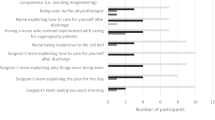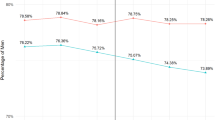Abstract
It is well established that resident’s exposure and training are of primary importance and positively correlated with patient and health quality outcomes. We aimed to compare and contrast urology residents’ self-reported perspectives and attitudes toward exposure and education of andrology and male infertility during residency in both the United States and Europe. We performed a cross-sectional design study using a survey that was distributed to a representative sample of American and European urology residents. The survey included questions regarding demographics, and the residents’ perception and description of their training in this specific subspecialty. Response data were analyzed using Chi-square tests. Sixty-five percent of European and thirty-five percent American urology residents reported feeling uncomfortable in a new consultation evaluating an infertile patient and interpreting semen analyses. Surprisingly, more than half of responders replied that they would not go to their own training institutions seeking for male fertility care (78% US and 58% Europeans). In the comparative analysis, although no differences were observed in the very low number (18%) of hospitals that offer formal microsurgical training for urology residents between the US and Europe, more US institutions were reported to have an operating microscope for urology (68% vs. 41%), and more US residents replied reported participating in at least one urologic surgery using the microscope (65% vs. 34%). In conclusion, both American and European residents shared the same frustration regarding their education and exposure to andrology and male infertility during residency training. Collaborative efforts between stakeholders are needed to establish a clear and focused curriculum and training objectives to eliminate this educational gap.
This is a preview of subscription content, access via your institution
Access options
Subscribe to this journal
Receive 8 print issues and online access
$259.00 per year
only $32.38 per issue
Buy this article
- Purchase on Springer Link
- Instant access to full article PDF
Prices may be subject to local taxes which are calculated during checkout



Similar content being viewed by others
References
Nieschlag E. Scope and Goals of Andrology. In: Nieschlag E., Behre H.M., Nieschlag S. (eds) Andrology. Springer, Berlin, Heidelberg. https://doi.org/10.1007/978-3-540-78355-8_1 (2010).
Ghayda RA, Bakare T, Ohlander S, Pagani R, Niederberger C. Mp19-19 andrology/male infertlity subspecialty exposure during U.S based urology residency training. J Urol. 2018;e251:199.
Ghayda RA, Bakare T, Ohlander S, Pagani R, Niederberger C. Andrology/male infertlity subspecialty exposure during U.S based urology residency training. Fertil Steril. 2017;108.
Cantrill JA, Sibbald B, Buetow S. The Delphi and Nominal Group Techniques in Health Services Research. Int J Pharm Pract. 1996;4:67–74.
Eysenbach G. Improving the quality of Web surveys: the checklist for reporting results of internet E-surveys (CHERRIES). J Med Internet Res. 2004;6:e34.
Vandenbroucke JP, von Elm E, Altman DG, Gøtzsche PC, Mulrow CD, Pocock SJ, et al. Strengthening the reporting of observational studies in epidemiology (STROBE): explanation and elaboration. PLoS Med. 2007;4:e297.
Von Elm E, Altman DG, Egger M, Pocock SJ, Gøtzsche PC, Vandenbroucke JP, et al. Strengthening the reporting of observational studies in epidemiology (STROBE) statement: guidelines for reporting observational studies. BMJ 2007;335:806–8.
Cuschieri S. The STROBE guidelines. Saudi J Anaesth. 2019;13 Suppl 1:S31–4.
Research Electronic Data Capture. https://www.project-redcap.org/. September 3rd 2019.
HHS Office of the Secretary, Office for Civil Rights, & Ocr. Sharing consumer health information? https://www.hhs.gov/hipaa/for-professionals/special-topics/hipaa-ftc-act/index.html (2017).
US Census Bureau. 2010 Census regions and divisions of the United States. https://www.census.gov/geographies/reference-maps/2010/geo/2010-census-regions-and-divisions-of-the-united-states.html (2018).
UNSD. Methodology. https://unstats.un.org/unsd/methodology/m49/. September 3rd 2019.
European Health Information Gateway. https://gateway.euro.who.int/en/. September 3rd 2019.
Acosta D, Castillo-Angeles M, Garces-Descovich A, Watkins AA, Gupta A, Critchlow JF, et al. Surgical practical skills learning curriculum: implementation and interns’ confidence perceptions. J Surgical Educ. 2018;75:263–70.
Schieman C, Ujiie H, Donahoe L, Hanna W, Malthaner R, Turner S, et al. Developing a national, simulation-based, surgical skills bootcamp in general thoracic surgery. J Surg Educ. 2018;75:1106–12.
Chee YE, Newman LR, Loewenstein JI, Kloek CE. Improving the teaching skills of residents in a surgical training program: results of the pilot year of a curricular initiative in an ophthalmology residency program. J Surg Educ. 2015;72:890–7.
Linden-Castro E, Pelayo-Nieto M, Ramírez-Galindo I, Guzmán-Hernández F, Catalán-Quinto G, Rodríguez-Covarrubias F, et al. Urology training in Mexico: residents’ perspective. Gac Med Mex. 2016;152:339–44.
Dy GW, Osbun NC, Morrison SD, Grant DW, Merguerian PA. Exposure to and attitudes regarding transgender education among urology residents. J Sex Med. 2016;13:1466–72.
Sarkissian H, Hardy S, Plante M, Mingin G. Pediatric resident exposure to urology: identifying a need. J Urol. 2013;190:1618–21.
Cabello-Benavente R, González-Enguita C. Residency in urology and training in kidney transplantation. Results of a national survey. Actas Urológicas Españolas. 2015;39:303–9.
Furriel FT, Laguna MP, Figueiredo AJ, Nunes PT, Rassweilervv JJ. Training of European urology residents in laparoscopy. BJU Int. 2013;112:1223–8.
Ehdaie B, Tracy C, Reynolds C, Cung B, Thomas K, Floyd T, et al. Evaluation of laparoscopic curricula in American Urology Residency Training. J Endourol. 2011;25:1805–10.
Krausz C, Brannigan RE, Sigman M. Subspecialty training in andrology. Fertil Steril. 2015;104:12–5.
Hajebrahimi S, Mostafaie A. How to teach evidence-based medicine to urologists. Indian J Urol. 2011;27:490–3.
Vinagre G, Villa J, Amillo S. Microsurgery training: does it improve surgical skills? J Hand Microsurg. 2017;9:47–8.
Atan A. Training problems of residents in urology. Turk J Urol. 2016;42:117–9.
Turner KA, Rambhatla A, Schon S, Agarwal A, Krawetz SA, Dupree JM, et al. Male infertility is a women’s health issue—research and clinical evaluation of male infertility is needed. Cells. 2020;9:990.
Lotti F, Frizza F, Balercia G, Barbonetti A, Behre HM, Calogero AE, et al. The European Academy of Andrology (EAA) ultrasound study on healthy, fertile men: clinical, seminal and biochemical characteristics. Andrology. 2020; https://doi.org/10.1111/andr.12808.
EAA European Academy of Andrology. http://www.andrologyacademy.net/education. September 3rd 2019.
Author information
Authors and Affiliations
Corresponding author
Ethics declarations
Conflict of interest
The authors declare that they have no conflict of interest.
Additional information
Publisher’s note Springer Nature remains neutral with regard to jurisdictional claims in published maps and institutional affiliations.
Supplementary information
Rights and permissions
About this article
Cite this article
Ghayda, R.A., Carrion, D.M., Gomez Rivas, J. et al. Knowledge gap across continents: the andrology and male infertility exposure among urology residents in the United States and Europe. Int J Impot Res 33, 603–610 (2021). https://doi.org/10.1038/s41443-020-00342-2
Received:
Revised:
Accepted:
Published:
Issue Date:
DOI: https://doi.org/10.1038/s41443-020-00342-2



